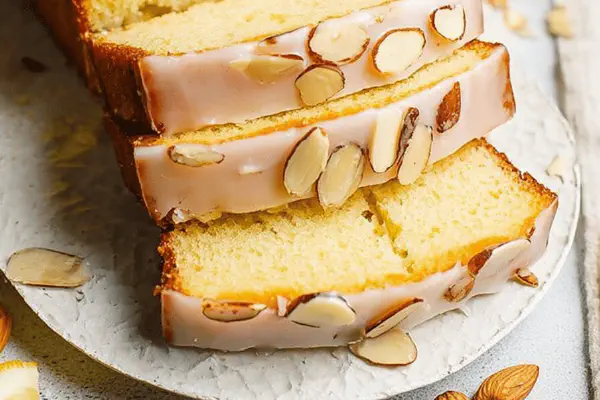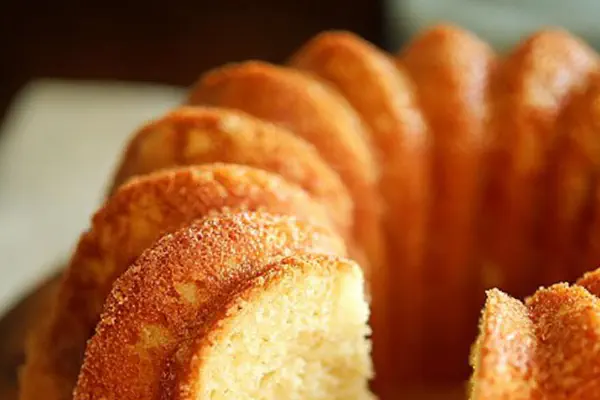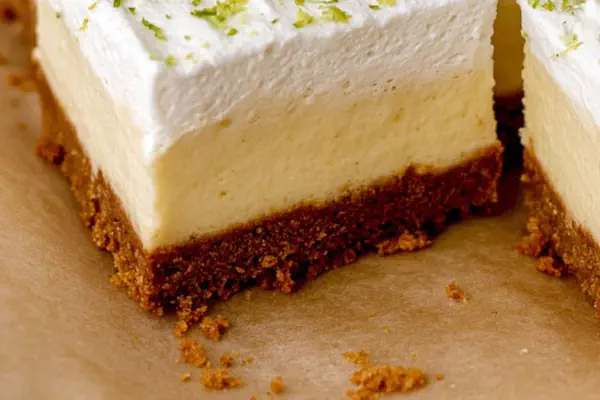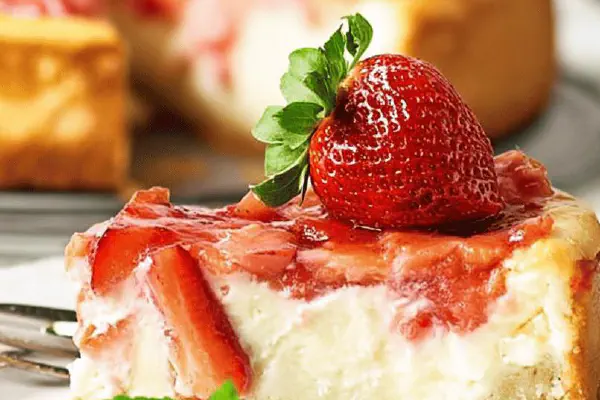Iced Almond Lemon Loaf

E
By Emma
Certified Culinary Professional
•
Recipe tested & approved
A zesty almond lemon loaf with a luscious yogurt glaze. Combines almond meal with flour for texture and tang from lemon zest and juice. Butter and sugar creamed until airy create a light crumb. Eggs added slowly to keep emulsification steady. Balanced leavening from baking powder and soda. Yogurt brings moisture and a slight tang, helping structure and crumb. Glaze made from confectioners sugar, yogurt, and lemon juice, drizzled or spread for a thin, tart veil. Baked until golden brown and tested visually and tactually, not just by time.
Prep:
20 min
Cook:
55 min
Total:
75 min
Servings:
9 servings
#American
#loaf cake
#almond
#lemon
#yogurt
#baking
Hit that oven switch straight away, butter that pan like you mean it. Flour, baking powder, soda, salt–sifted to keep air in, almond meal thrown in for grit and flavor. Butter and sugar get whipped till cloud-like. Eggs added slow- trust me, emulsifying’s key here. Almond extract, not too much or it’s cloying but enough to notice. Yogurt gives the batter a tangy moisture punch, stops dryness that loafs usually get stuck with. The batter thickens but stays flowy. Baking’s a waiting game but watch color and bounce. The glaze? Not too thin or it just pools, not thick or it crusts hard. The zing of lemon grease all senses. Keep it covered, or it’ll dry out and no one wants that crumbly disappointment. Learned that the hard way.
Ingredients
- 1 cup all-purpose flour
- 3/4 cup almond meal (finely ground almonds)
- 1 teaspoon baking powder
- 1/2 teaspoon baking soda
- 1/2 teaspoon salt
- 1 tablespoon lemon zest (from 1 large lemon)
- 3/4 cup unsalted butter (softened)
- 1 cup granulated sugar
- 3 large eggs
- 1 teaspoon almond extract (can substitute with vanilla extract)
- 1/2 cup plain whole-milk yogurt (or Greek yogurt)
- Icing: 1 cup confectioners sugar (sifted)
- Icing: 1/4 cup plain yogurt
- Icing: 1 to 2 tablespoons fresh lemon juice
About the ingredients
Almond meal’s a game changer; do not skip or swap for plain meal without nuts unless you want a total flop. The yogurt adds moisture and tang but Greek yogurt can make it denser; thin with a tablespoon milk if needed. Butter at room temp is crucial for creaming; cold butter means lumps and tough baked goods. You can swap almond extract for vanilla extract but it’s less punchy, and the almond meal is there to amplify that flavor. Lemon zest fresh crushed is a must; dried zest just falls flat. Baking powder and baking soda balance pH preventing metallic aftertaste. Substituting yogurt with sour cream works if you are out but expect a different crumb texture. Confectioners sugar must be sifted fully to avoid clumps in icing. Juice quality impacts glaze acidity and texture—use fresh lemons. Simple pantry adjustments make or break this loaf. No shortcuts here.
Method
- Set oven to 350F with rack in middle. Butter a 9x5-inch loaf pan generously, corners and edges too to prevent burning or sticking.
- Whisk sifted flour, baking powder, soda, salt together. Stir in almond meal and lemon zest thoroughly. Those dry bits bite in later, not just filler.
- Cream butter and sugar using paddle attachment on low-medium speed. Don’t rush- takes about 5 minutes. Look for pale, fluffy texture, like whipped cream but stiffer.
- Add eggs one at a time on low, scraping bowl sides so nothing’s ignored. Add almond extract last- that punch sneaks up on you.
- Fold in half the dry mix slowly, just until no pockets remain. Follow immediately with yogurt—curdle risk if dry goes all at once. Then the rest of dry stuff. Don’t overmix or gluten will toughen crumb.
- Speed up mixer to medium for 1-2 minutes. This beats some structure in, no dense, wet gut feeling inside once baked.
- Spoon batter into pan. Tap gently on countertop to settle bubbles. Smooth top - we want even rise and no cratered surface.
- Bake approx 50-60 mins but watch the top- should be golden, edges pulling from pan. Insert skewer in center, no sticky batter clinging. Toothpick with a few moist crumbs okay, raw batter no.
- Cool 15 minutes inside pan on wire rack. Run knife between cake and pan edges carefully, invert onto rack, peel pan off. Let cake cool completely before glaze.
- For glaze, sift confectioners sugar into bowl. Whisk in yogurt until thick, shiny. Add lemon juice in teaspoons until it drips slowly off whisk, not runny. Thick enough to hold shape but fluid for drizzle.
- Drizzle over cake in zig-zag or spread gently with offset spatula for thin coat. Let set 30 minutes at room temp or fridge to firm glaze.
- Keep covered loosely at room temp max 48hr. Could refrigerate wrapped for up to 5 days but bring back to room temp before slicing to soften butter and crumb again.
Cooking tips
Creaming butter and sugar right sets the stage—takes 5 good minutes, fluff is non-negotiable. Adding eggs slow keeps emulsion steady; rushed, and batter splits or looks curdled. Folding dry ingredients needs patience—overwork gluten and you’ll get a tough, rubbery cake. Yogurt incorporation last is a trick I picked up to keep the batter tender but structured. Baking time can vary; look for that golden hue, edges pulling slightly back from pan, and skewer with a few moist crumbs but no wet batter. Cooling inside pan first prevents collapse, then inversion releases steam evenly. The glaze needs TLC balancing thickness; too thin runs off and too thick cracks. Drizzle or spread, your call. Let it set fully or it’ll be messy when cutting. Keep cake covered but not airtight right away, the glaze breathes but you don’t want dry cake. Always best fresh but leftovers can surprise when warmed before serving.
Chef's notes
- 💡 Butter at room temp only. Cold butter wrecks creaming, lumps form, air won’t whip. Paddle attachment moves slow, toss sugar in gradually. Takes 5 minutes straight, look pale, fluffy, almost stiff but soft enough to fold. Rushing kills texture.
- 💡 Add eggs one at a time, scrape bowl sides. Avoid curdle by keeping speed low. Almond extract last, subtle punch deserving gentle fold. Add dry in halves, then yogurt between to prevent clumps, sudden dry dump breaks batter flow. Folding not mixing.
- 💡 Don’t overmix dry ingredients or gluten tightens crumb; tough, rubbery loops happen fast. Yogurt adds moisture but can weigh batter; Greek yogurt denser, thin with milk if batter drags. Keep batter loose but structured, feeds rise.
- 💡 Watch baking, 50-60 minutes but color tells story. Golden top, edges pulling from pan. Skewer test—moist crumbs okay, wet batter no. Tap pan lightly after scooping batter for bubble release; surface smooth, no crater means even rise.
- 💡 Glaze thickness is tricky. Too runny runs off; too firm cracks. Sift sugar well, whisk with yogurt slowly. Lemon juice in teaspoons added last, drip off whisk like slow honey, not thin syrup. Apply zig-zag for texture or spread thin for subtle glaze.
Common questions
Can almond extract be replaced?
Yes, vanilla extract works. Less punch though. Almond meal amps flavor so vanilla might dull overall. Adjust sugar down slightly if too sweet.
Yogurt alternatives?
Sour cream can swap if out of yogurt. Texture changes, crumb denser. Adjust moisture with splash milk. Use plain dairy for mild tang, Greek yogurt alters density.
Batter too thick or dry?
Add more yogurt or splash milk. Watch folding—overmix stiffens gluten, crumb toughens. Dry ingredients folded gently, don’t dump at once. Mix till just combined.
Storing loaf advice?
Cover loosely room temp 48 hours max. Refrigerate wrapped up to 5 days. Bring to room temp before slicing to soften crumb and butter. Glaze keeps moist but cracks if too cold.



